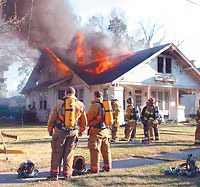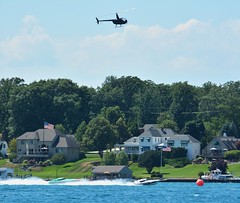“Hey guys come here a minute. I’d like to get your input on what you think the best approach is here. Jack thinks the best practice is an aerial approach, Jim is advocating for the “old school” water-in-the-window and the rest of you really haven’t weighed in yet. I’ve asked the neighbor if we can borrow their kitchen table for a while for a little bit of a team session on this one.” states Fire Chief Dan.
Dan has recently read a number of leading business publications that talk about the importance of fostering a good teamwork environment and the importance of team-based decisions. He wants the best for his department. His client Mrs. Ford, the homeowner, however is not fully “bought-in” to the team-based decision approach. She just wants the fire out.
When I ask any group of consultants how they make or influence decisions with a client group they invariably provide a “Fire Chief Dan” type of answer; consensus, team-based, equal vote, team “buy-in” etc. While I agree that team based decisions are the best for team commitment to execution there are at times a critical requirement for different styles. The best consultants learn how to correctly identify those situations and then apply the correct style.
You don’t think there are house fires in IT? Think again. Let’s have your client’s national retail electronic payment system go down on December 24th. Does your client want a team conference?
Let’s talk about influencing styles. There are “Push” and “Pull” styles.
Push styles
|
Style |
Force |
Rules and Standards |
Exchange |
Persuasion |
Assertion |
|
Example |
Do this now or else. |
Sarbane-Oxley requires compliance to the following. |
If you do this then I can do that |
If you do this based on your trust and experience with me. I have not let you down before. |
By doing the following, the following will result |
|
Sample usage |
Engineer with down mission-critical system |
Governance consultant |
Architectural Design Trade-off |
Long Term Strategy engagement direct with Sponsor client |
ROI, TCO reduction, ROA |
|
Type of Client Situation |
Emergency |
Government, Large Institution |
Technical |
1:1 or trusted team |
Analytical client, CFO |
|
When to Use |
911 |
Policy centric, bureaucratic environments |
Technical and business trade-offs example: high availability versus cost savings |
When you know the direction is correct and you are willing to put your credibility on the line or know the client will be tolerant of a failure. |
In process, loose relationship with client, early relationship with client, risk averse client (personally) |
|
Impact |
Short Term compliance Long Term damage |
Safe and slow progress with minimal risk to client’s personally. |
Quick, concise All parties may not be pleased |
Quick. Clearly leaves liability with the persuader. |
Moderately quick. Factual Good buy-in |
|
When Not to Use |
Non-urgent situations or culturally prohibitive |
Time sensitive results required. |
When exchange is perceived as win/loss. |
Uncertainty of the direction |
Expectations that you alone are to provide guidance |
Pull Styles
| Style |
Personal Magnetism |
Visioning |
Bridging |
Environmental Management |
Joint Solutioning |
| Example |
This is why I get up in the morning. To tell people about X. I love X. |
Can you imagine? Walk with me into the future call centre. |
Now if we add this then the sales group can receive the following benefit earlier.. |
We have asked Jane and Bob from Corporate records to join us today to talk about the impact on compliance if we do or do not implement the records management feature. |
Now we are looking for a roundtable discussion on this Use Case. Every feature request is valid at this point and no idea is stupid. |
| Sample Usage |
Steve Ballmer |
Initial concept development Initial architecture development etc. |
Feature scoping, deliverable planning |
Group meetings Steering committee |
Group meetings |
| Type of Client Situation |
CIO roundtable Large Conference etc. |
Envisioning Planning Pre-Sales |
Giving each stakeholder a portion of what they want. Trying to create synergy or where necessary. make compromise less painful. |
In-process decisions affecting broad range of stakeholders. Different knowledge levels in participants. |
Joint requirements gathering sessions. |
| When to Use |
Peer or world-class notable. |
Early in the process. Best Opportunity to validate and define scope by providing a bigger vision. |
Mid-process where group decisions and trade-offs must be made. |
Mid-process where group decisions and trade-offs must be made. Committee may have incomplete knowledge. |
As often as you can. |
| Impact |
Initial kick to start looking at an area. |
Expands horizon, validates entry and diagnosis steps by providing big picture context. |
Creates uniformity and encourages teamwork. |
Can bring all members up to speed without singling out any member. |
Highest Team buy-in, participation and commitment. |
| When Not to use |
Non-peer, 1:1 |
In development. |
1:1 |
1:1 |
1:1 Ultra-dominant client. |
- Pull styles help to draw the client out and to talk about their concerns and motivations.
- Push styles inform or impose on the client and are most useful when the client is uncertain.
- If you feel resistance from the client, switch to pull.
Top Tip
In every interaction with a client seek to achieve a balance between push and pull.
Don’t fool yourself. No matter the role you have been asked to do, you are consulting and by definition, the client has asked and is paying for your
professional influence on their project.









Pingback: Infinite Shades of Grey – A year later and a little greyer | Infinite Shades of Grey
Pingback: What’s wrong with Arrogance? | Infinite Shades of Grey
Pingback: The perfect consultant – The Ambivert? | Infinite Shades of Grey